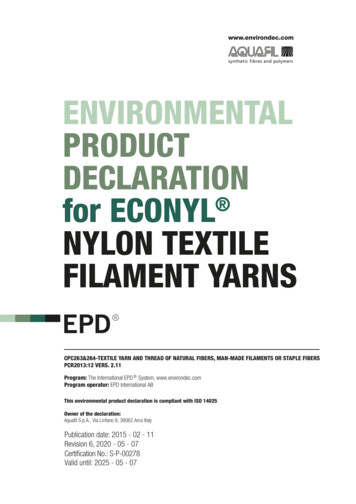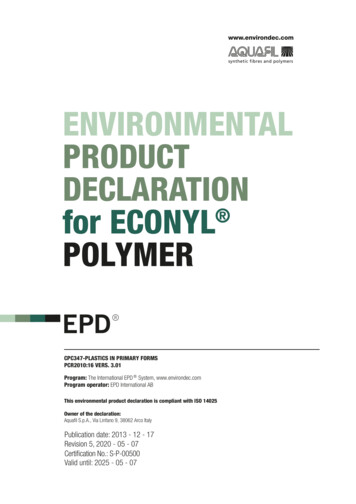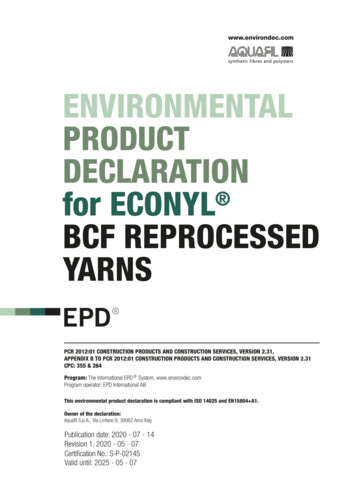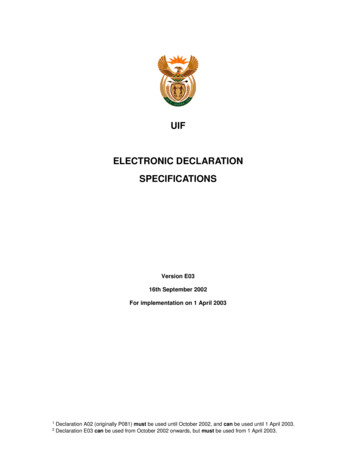
Transcription
ENVIRONMENTALPRODUCTDECLARATION for ECONYLNYLON TEXTILEFILAMENT YARNSCPC263&264-TEXTILE YARN AND THREAD OF NATURAL FIBERS, MAN-MADE FILAMENTS OR STAPLE FIBERSPCR2013:12 VERS. 2.11Program: The International EPD System, www.environdec.comProgram operator: EPD International ABThis environmental product declaration is compliant with ISO 14025Owner of the declaration:Aquafil S.p.A., Via Linfano 9, 38062 Arco ItalyPublication date: 2015 - 02 - 11Revision 6, 2020 - 05 - 07Certification No.: S-P-00278Valid until: 2025 - 05 - 07
EPD for Aquafil ECONYL NTF YarnsCOMPANYAND PRODUCTRelated informationRev. 6, 2020 - 05 - 07
EPD for Aquafil ECONYL NTF YarnsRev. 6, 2020 - 05 - 07THE COMPANYAquafil Group history began in 1969, when the Bonazzi family built the firstmanufacturing plant in Arco (Trentino Alto Adige region, Italy). In 1970, theGroup began the polymerization and production of polyamide 6 at this facility,which started Aquafil’s market share acquisition in the BCF yarn sector(polyamide yarn for textile flooring). During the ‘80s, significant investmentsallowed a consolidation and diversification of the Group’s activities. The mostsignificant diversification of the Group's operation occurred in 1995 when theAquafil Group finalized the first privatization of a public company in the newlyborn Republic of Slovenia. This acquisition allowed Aquafil to start its NylonTextile Filament (NTF) product area.Meanwhile, the Group continued to widen its product offering by openingseveral production plants in Europe and entering (with its “Polyamide productspriority focus” always in mind) the Engineering Plastics business to supplyengineering plastics to the automotive, electronics and construction industries.At the same time, the Group started its internationalization process withthe creation of Aquafil USA, based in Cartersville, Georgia (USA).Between 2000 and 2010, the Group expanded its presence in all three keymarkets where it was operating (carpet yarn, textile yarn and engineeringplastics), gradually becoming a global leader in the manufacturing of Polyamide6 fibers. In 2005, a manufacturing facility was established in Thailand forprocessing and marketing BCF products for the carpet industry in the Asianarea. In 2009, a new manufacturing facility was built in China to assist in theever-growing Asian market. In 2013, the Group sold the Engineering Plasticsdivision to DOMO and acquired DOMO's BCF business Xentrys.In 2007 the company started the development of a visionary project aligned withits manufacturing and market growth focus. Driven by a genuine concern for theenvironment, resources and investments were dedicated to the design andconstruction of the ECONYL Regeneration Plant (the recycling of pre- andpost-consumer Polyamide 6 waste material), which was launched in 2011. As of2019, the Group operates 16 manufacturing plants worldwide with more than2,900 employees, in eight countries (Italy, Slovenia, Croatia, Germany, UnitedKingdom, USA, Thailand and China) on three continents (Europe, North Americaand Asia).3
EPD for Aquafil ECONYL NTF YarnsRev. 6, 2020 - 05 - 07IT OPERATES 2 DIFFERENT PRODUCT AREAS: BCFCarpet yarn for the flooring market NTFSpecial yarns for sportswear and fashion applications In 2008, during the engineering and design phase of Aquafil's ECONYLpRegeneration System, a third operational unit was created - Energy &Recycling.This Energy & Recycling operational unit is dedicated to the promotion ofsustainability and environmental issues. It has a transverse nature in respect tothe other product areas, providing solutions and innovative technologies in thearea of energy, recycling and the promotion of the culture of sustainability bothinside and outside of the Group.4
EPD for Aquafil ECONYL NTF YarnsRev. 6, 2020 - 05 - 07PROGRAM INFORMATIONPROGRAM OPERATOREPD international AB: Valhallavägen 81, SE-114 27 Stockholm Sweden;E-mail: info@environdec.comCOMPARABILITYEPDs within the same product category but from different programs may not becomparable.OWNERSHIPThe EPD owner has the sole ownership, liability, and responsibility for this EPD.VERIFICATION INFORMATIONCPC263&264-Textile yarn and thread of natural fibers, man-made filaments orstaple fibersPCR2013:12 vers. 2.11PRC review was conducted by: Technical Committee of the International EPD SystemIndependent third-party verification of the declaration and data, according toISO 14025:2010:EPD process certificationX EPD verification5
EPD for Aquafil ECONYL NTF YarnsRev. 6, 2020 - 05 - 07Third party verifier:Bureau Veritas, accredited by SWEDACwww.bureauveritas.comProcedure for follow-up data during EPD validity involves third-party verifier:XYESNO6
EPD for Aquafil ECONYL NTF Yarns3Rev. 6, 2020 - 05 - 07PRODUCT INFORMATIONOWNER OF THE EPDAquafil S.p.A., Via Linfano 9, 38062 Arco, ItalyP: 39 0464 581111E-mail: info@aquafil.comTo get more information about this environmental declaration or about Aquafilactivities please contact:Lucija AleksicE- mail: lucija.aleksic@aquafil.comT. 386 (0)40 193499LCA performed by:Jaka JelencE-mail: jaka.jelenc@aquafil.comT. 386 (0)30 646255DESCRIPTION OF THE PRODUCTECONYL NTF yarns are Nylon textile filament yarns, made from 100% recycledPA6 polymer. Nylon textile yarns can be reprocessed by beaming andtexturizing processes. ECONYL Nylon Textile Filament yarn is used in severalapplications such as swimwear, intimate apparel, fashion, sports and tights.This EPD refers to two types of Nylon Textile Filament yarns ECONYL FDY yarns on beam ECONYL texturized yarns on conesEnvironmental performances for each group of yarn is reported separately.Each group of yarn is consisting of several similar products, but differences interms of parameters are not significant for all three groups of products.7
EPD for Aquafil ECONYL NTF YarnsRev. 6, 2020 - 05 - 07IDENTIFICATION OF THE PRODUCT ACCORDING TO THE UN CPC SCHEME264 – Textile yarn and thread of man-made filaments or staple fibres.PRODUCTION SITES INCLUDED IN EPD AquafilSLO d.o.o. - Ljubljana (Letališka cesta 15, 1000 Ljubljana,Slovenia) process E, F, G & H AquafilSLO d.o.o. - Ajdovščina (Tovarniška cesta 15, 5270 Ajdovščina,Slovenia) process I AquafilCRO d.o.o. (Ul. Milana Prpića 114, 49243, Oroslavje, Croatia) process L AquafilSLO d.o.o. - Senožeče (Senožeče 151, 6224 Senožeče, Slovenia) process K Aquafil Carpet Recycling (ACR#1) Phoenix (3555 W. Washington street, 85009Phoenix, USA) process S Production country: Slovenia, Croatia Reference markets: apparel industryISO standardISO 9001 : 2015ISO 14001 : 2015OHSAS 18001 : 2007ISO 50001 : XXXACR#1PhoenixXPRODUCT CHARACTERISTICSTECHNICAL SPECIFICATIONNAMETEST METHODECONYL FDY yarn on beams-100% Polyamide 6EN ISO 1043-1:2011ISO 2076: 2010Filament yarnISO 8159:1987Type of processingFully Drawn YarnBISFAIntended useSee section 2.1-Resulting linear density17 dtex-78 dtexISO 2060-1994various-Commercial article descriptionBasic polymer; % of basic polymer /Generic name of synthetic fiber; % ofsynthetic fiberType of yarn or fiberFilament number8
EPD for Aquafil ECONYL NTF YarnsTECHNICAL SPECIFICATIONNAMETEST METHODECONYL textured yarn on cones-100% Polyamide 6EN ISO 1043-1:2011ISO 2076: 2010Textured Filament yarnISO 8159:1987Partially Oriented Yarn / False Twist TexturizingBISFASee section 2.1-17 dtex-120 dtexISO 2060-1994various-Commercial article descriptionBasic polymer; % of basic polymer /Generic name of synthetic fiber; % ofsynthetic fiberType of yarn or fiberType of processingRev. 6, 2020 - 05 - 07Intended useResulting linear densityFilament numberGEOGRAPHICAL SCOPE OF THE EPDGlobal.DECLARED UNITDeclared unit is 1 kg of ECONYL yarn delivered and including primarypackaging.REFERENCE SERVICE LIFEThis EPD does not indicate RSL.DATA COLLECTIONLife cycle assessment primary data of processes owned by Aquafil groupwere collected from period of January 2019 to December 2019.BACKGROUND DATA AND METHODAll the background data relevant for modelling were taken from Gabidatabase – service pack 40, (update 2020). CML2001, January 2016assesment method is used.9
EPD for Aquafil ECONYL NTF YarnsRev. 6, 2020 - 05 - 07SYSTEM BOUNDARIESUPSTREAMExtraction of non renewable resourcesWaste collectedCrude oil refineryprocessesInorganic synthesisproductionUSA Fluff/Granulateproduction (S)PA6 Fishing netspretreatmentMaterial storageand handlingWaste pretreatment - Ajdovščina (I)Depolymerization (E)Polymerization (F)CORESpinning POY (G)Spinning FDY (H)Texturising (L)Warping (K)DOWNSTREAMDeliveryUse PhaseProduct packaging and end of lifePROCESSES RELATED TO THEPRODUCTION OF AUXILIARY CHEMICALS10PROCESSESINCLUDED IN EPDPROCESSES NOTINCLUDED IN EPD
EPD for Aquafil ECONYL NTF YarnsRev. 6, 2020 - 05 - 07CONSIDERED LIFE CYCLE STAGESUpstream processes include: extraction of non-renewable resources additives and auxiliary’s production all relevant transportation waste materials, that are entering pretreatment plant and areconstituted of three main types of waste:A.PA6 fishing nets collectionB.PA6 carpets, fluff or granulesC.Oligomers and other plastics waste generated by polymer industriesDepending on the type and shape of waste, it can be cleaned, sorted, grinded,washed, granulated or pelletized.All waste material is characterized with the specific feedstock energy enteringthe system and the processes are described by means of energy use andemissions. ECONYL plant operationA.washing (if and when necessary)B.depolymerization (where specific mix of waste is transformed backinto secondary raw material - caprolactam)C. purification of caprolactampolymer productionAll energetic input flows (electricity, heating fuels, steam.) and water consumptionto the upstream processes are considered. All emissions to air, water and soiland treatment of waste and wastewater generated are considered as well.Core Process include: spinning process (POY or FDY) post spinning processes; texturizing or warping transportation of materials into the core processesAll energetic input flows (electricity, heating fuels, steam.) and water consumptionto the upstream processes are considered. All emissions to air, water and soiland treatment of waste and wastewater generated are considered as well.11
EPD for Aquafil ECONYL NTF YarnsRev. 6, 2020 - 05 - 07Downstream processes include transportation to average retailer / distributionplatform: 300 km by truckUse phase and end of life of product are not included.CUT OFF CRITERIAIn general, Life Cycle Inventory data for a minimum of 99% of totalinflows (mass and energy) to the upstream and core module is included.All energy inflows are considered in the study.Primary packaging material was considered: polymerization process: tank truck spinning (POY & FDY) and texturizing: paper tubesExcluded secondary packaging materials are: paper boxes & separators,wooden pallets, labels, plastic bags, extensible film & adhesive tape.12
EPD for Aquafil ECONYL NTF Yarns4Rev. 6, 2020 - 05 - 07CONTENT DECLARATIONA. ECONYL FDY YARNS ON BEAMTYPE OF PRODUCT/SERVICE% OF MATERIAL BY WEIGHTCAS NUMBERPolyamide Water3-47732-18-5TOTAL100%Spin FinishPercent of which main materials, pigments anddye stuff, and other materials is bio-based0%B. ECONYL TEXTURIZED YARNS ON CONESTYPE OF PRODUCT/SERVICE% OF MATERIAL BY WEIGHTCAS NUMBERPolyamide Water3-47732-18-5TOTAL100%Spin FinishPercent of which main materials, pigments anddye stuff, and other materials is bio-based0%ECONYL yarns do not contain any materials / substances hazardous to healthand the environment (carcinogenic, mutagenic or toxic to reproduction, PBT,vPvB) or substances of very high concern (SVHC), according to Regulation(EC) No 1907/2006 and Regulation (EC) No 1272/2008. Nylon Textile FilamentECONYL yarns are OEKOTEX 100 class I certified and OEKOTEX 100 classII certified.All types of yarns are produced out of 100 % recycled PA6 polymer, withpost-consumer and post-industrial recycled content certified by independentthird party DNV 18590-2008-PC-ITA-DNV.13
EPD for Aquafil ECONYL NTF Yarns5Rev. 6, 2020 - 05 - 07ENVIRONMENTAL PERFORMANCEPOTENTIAL ENVIRONMENTAL IMPACTS TABLE A. ECONYL FDY yarn on beams;IMPACT CATEGORIESUPSTREAMCOREDOWNSTREAMTOTALGWP biogenic*kg CO2 eq0,01-0,05-1,00E-04-0,05GWP fossil*kg CO2 eq0,770,260,021,05GWP Land use*kg CO2 eq2,55E-039,67E-041,59E-043,68E-03GWP total*kg CO2 eq0,780,210,021,01Acidification Potentialskg SO2 eq7,53E-031,07E-038,77E-058,69E-03Photochemical Ozone Creation P.kg C2H2 eq5,76E-041,07E-048,14E-066,91E-04Eutrophication Potentialskg PO4 eq1,97E-037,55E-042,16E-052,75E-03Abiotic Depletion Potential - elementskg Sb eq4,14E-074,29E-071,62E-098,44E-07Abiotic Depletion Potential - fossil fuelMJ net calorific value8,103,270,2611,63m³ eq1,060,171,76E-041,23Water scarcity potentialTotals may not match, because of rounded data TABLE B. ECONYL texturized yarn on cones;IMPACT CATEGORIESUPSTREAMCOREDOWNSTREAMTOTALGWP biogenic*kg CO2 eq0,01-0,27-1,00E-04-0,26GWP fossil*kg CO2 eq0,760,340,021,12GWP Land use*kg CO2 eq2,51E-038,12E-031,59E-040,01GWP total*kg CO2 eq0,770,080,020,87Acidification Potentialskg SO2 eq7,41E-031,60E-038,77E-059,10E-03Photochemical Ozone Creation P.kg C2H2 eq5,67E-041,28E-048,14E-067,04E-04Eutrophication Potentialskg PO4 eq1,94E-031,01E-032,16E-052,97E-03Abiotic Depletion Potential - elementskg Sb eq4,08E-076,23E-071,62E-091,03E-06Abiotic Depletion Potential - fossil fuelMJ net calorific value7,983,890,2612,13m³ eq1,040,511,76E-041,55Water scarcity potentialTotals may not match, because of rounded data14
EPD for Aquafil ECONYL NTF YarnsRev. 6, 2020 - 05 - 07USE OF RESOURCES TABLE A. ECONYL FDY yarn on beamsUNITUPSTREAMCOREDOWNSTREAMTOTALUse as energy carrierMJ, net calorific value18,3825,840,0144,24Use as raw materialsMJ, net calorific value0000TOTALMJ, net calorific value18,3825,840,0144,24Use as energy carrierMJ, net calorific value8,963,770,2813,01Use as raw materialsMJ, net calorific value34,420034,42TOTALMJ, net calorific 1,58001,58PARAMETERPrimary energyresources renewablePrimary energyresources - nonrenewableUNITPARAMETERSecondary materialkgRenewable secondary fuelsMJ, net calorific value0000Non-renewable secondary fuelsMJ, net calorific value0000UNITUPSTREAMCOREDOWNSTREAMTOTALNet use of fresh waterm³0,034,25E-031,71E-050,03Agricultural land use for renewablematerial productionm²0000PARAMETERTotals may not match, because of rounded data TABLE B. ECONYL texturized yarn on conesUNITUPSTREAMCOREDOWNSTREAMTOTALUse as energy carrierMJ, net calorific value18,1028,820,0146,94Use as raw materialsMJ, net calorific value0000TOTALMJ, net calorific value18,1028,820,0146,94Use as energy carrierMJ, net calorific value8,834,740,2813,85Use as raw materialsMJ, net calorific value33,920033,92TOTALMJ, net calorific value42,754,740,2847,77PARAMETERPrimary energyresources renewablePrimary energyresources - nonrenewable15
EPD for Aquafil ECONYL NTF YarnsUNITPARAMETERRev. 6, 2020 - 05 - 07UPSTREAMCOREDOWNSTREAMTOTAL1,55001,55Secondary materialkgRenewable secondary fuelsMJ, net calorific value0000Non-renewable secondary fuelsMJ, net calorific value0000UNITUPSTREAMCOREDOWNSTREAMTOTALNet use of fresh waterm³0,030,011,71E-050,04Agricultural land use for renewablematerial productionm²0000PARAMETERTotals may not match, because of rounded dataWASTE PRODUCTION AND OUTPUT FLOWS TABLE A. ECONYL FDY yarn on beamsUNITUPSTREAMCOREDOWNSTREAMTOTALHazardous waste rdous waste disposedkg0,300,034,02E-050,33Radioactive waste REAMCOREDOWNSTREAMTOTALComponents for reusekg0000Material for recyclingkg0,160,1300,30Materials for energy recoverykg0000Exported energy, electricitykg0,60000,60Exported energy, thermalkg1,06001,06PARAMETERPARAMETERTotals may not match, because of rounded data TABLE B. ECONYL texturized yarn on conesUNITUPSTREAMCOREDOWNSTREAMTOTALHazardous waste rdous waste disposedkg0,290,034,02E-050,33Radioactive waste R16
EPD for Aquafil ECONYL NTF YarnsRev. 6, 2020 - 05 - 07UNITUPSTREAMCOREDOWNSTREAMTOTALComponents for reusekg0000Material for recyclingkg0,050,2200,26Materials for energy recoverykg0000Exported energy, electricitykg0,57000,57Exported energy, thermalkg1,01001,01PARAMETERTotals may not match, because of rounded dataOTHER ENVIRONMENTAL INDICATORS TABLE A. ECONYL FDY yarn on beamsUNITUPSTREAMCOREDOWNSTREAMTOTALkg DCB eq.1,10E 032330,3111,33E 03UNITUPSTREAMCOREDOWNSTREAMTOTALEnergy content of productMJ34,420034,42% of bio-based%0000PARAMETERCML2001 - Jan. 2016, FreshwaterAquatic Ecotoxicity Pot. (FAETP inf.)PARAMETERTotals may not match, because of rounded data TABLE B. ECONYL texturized yarn on conesUNITUPSTREAMCOREDOWNSTREAMTOTALkg DCB eq.1,08E 052080,3111,29E 03UNITUPSTREAMCOREDOWNSTREAMTOTALEnergy content of productMJ33,920033,92% of bio-based%0000PARAMETERCML2001 - Jan. 2016, FreshwaterAquatic Ecotoxicity Pot. (FAETP inf.)PARAMETERTotals may not match, because of rounded data17
EPD for Aquafil ECONYL NTF YarnsRev. 6, 2020 - 05 - 07BY - PRODUCT GENERATEDUNITUPSTREAMECONYL FDY yarn on beamsMJ/kg1,79ECONYL texturized yarn on conesMJ/kg1,77PARAMETER18
EPD for Aquafil ECONYL NTF Yarns6Rev. 6, 2020 - 05 - 07ADDITIONAL INFORMATIONThis chapter is intended to provide specific additional information about theECONYL Regeneration System as well as some comments of its environmentalbenefit.In 2009 we set ourselves the challenge of collecting waste material all over theworld and turning it into recycled polymers. It is possible to mention otherenvironmental benefits, besides those appreciated from the impact categoriesinvestigated in the present study. In fact, part of virgin raw materials extractionand natural resources exploitation is prevented by the use of waste otherwisedisposed of.The European Commission has estimated that the EU discards 5.8 million tonsof textiles and apparel every year, 75% of this is sent to landfill or incinerated, butthe vast bulk is destined for landfill. The USA generates 12.7 million tons of textilewaste; of this only 14.9% is recycled (US Environmental Protection Agency,2009), which means more than 85% is waste, again largely being sent to landfill.To put this number in context, in 2009 a total of 71.6 million tons of fiber wasused around the world. This means that the EU and the USA in one year alonediscarded 18.5 million tons which is equal to 26% of annual global fiber usage.Another aspect not directly emerging from the present study, which is worth amention, is the contribution to the prevention of oceans pollution from thecollection of fishing nets in their end-of-life.19
EPD for Aquafil ECONYL NTF YarnsADDITIONALINFORMATIONRev. 6, 2020 - 05 - 07
EPD for Aquafil ECONYL NTF Yarns7Rev. 6, 2020 - 05 - 07DIFFERENCES VERSUS PREVIOUS VERSION OF EPDThe main reason for GWP reduction compared to previous version of EPD is dueto implementation of 100% biomass steam consumption in AquafilSLO d.o.o.Ljubljana plant.21
Rev. 6, 2020 - 05 - 07References
EPD for Aquafil ECONYL NTF YarnsRev. 6, 2020 - 05 - 07References ISO 14025:2010Environmental labels and declarations — Type III environmental declarations — Principles andprocedures General Programme instructions 3.01CPC 263&264 - Textile yarn and thread of natural fibers, man-made filaments or staple fibersPCR2013:12 vers. 2.11 ISO EN 1043-1 :2011Plastics — Symbols and abbreviated terms — Part 1: Basic polymers and their specialcharacteristics ISO 2076:2010Textiles — Man-made fibres — Generic names BISFAINTERNATIONAL BUREAU FOR THE STANDARDISATION OF MAN-MADE FIBRES ISO 2060-1994Textiles — Yarn from packages — Determination of linear density (mass per unit length) by theskein method ISO 9001 : 2015Quality management systems — Requirements ISO 14001 : 2015Environmental management systems — Requirements with guidance for use OHSAS 18001: 2007Occupational Health and Safety Management
In 2013, the Group sold the Engineering Plastics division to DOMO and acquired DOMO's BCF business Xentrys. Meanwhile, the Group continued to widen its product offering by opening several production plants in Europe and entering (with its "Polyamide products priority focus" always in mind) the Engineering Plastics business to supply










